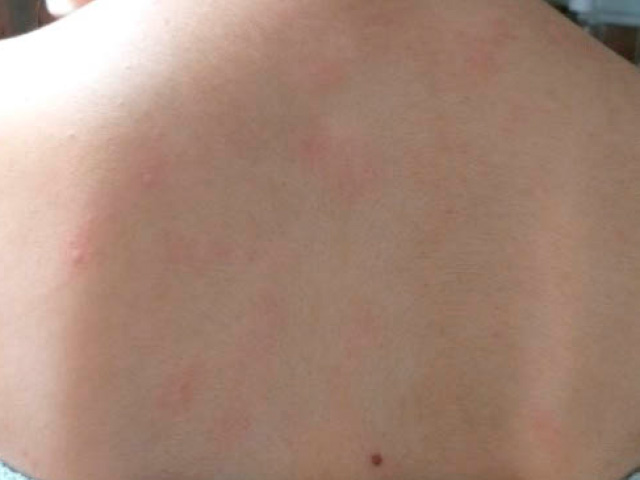Reporte de dos casos infrecuentes de urticaria inducible en niños y un caso de urticaria por presión en mujer adulta durante la actividad sexual
DOI:
https://doi.org/10.29176/2590843X.1703Palabras clave:
Antihistamínicos, Habón, Niños, Prurito, Urticaria crónica, Urticaria inducibleResumen
La urticaria crónica es una enfermedad bien definida en pacientes adultos; sin embargo, los datos son limitados en población pediátrica y en lo referente a la urticaria inducible en general. Esto lleva a retrasos en el diagnóstico y el tratamiento de la enfermedad, lo que genera grandes alteraciones en la calidad de vida de los pacientes. Se presentan tres casos poco usuales: uno de urticaria acuagenica, otro de urticaria colinérgica en niños, y uno de urticaria por presión durante la actividad sexual en una mujer adulta. Es importante la documentación de casos que describan el cuadro de presentación de las urticarias crónicas inducibles para establecer un mejor abordaje.
Biografía del autor/a
Nardey Crespo, Grupo de Alergología Clínica y Experimental, clínica IPS Universitaria, Universidad de Antioquia, Medellín, Colombia.
Grupo de Alergología Clínica y Experimental, clínica IPS Universitaria, Universidad de Antioquia, Medellín, Colombia.
Luís Santamaria, Grupo de Alergología Clínica y Experimental, clínica IPS Universitaria, Universidad de Antioquia, Medellín, Colombia.
Grupo de Alergología Clínica y Experimental, clínica IPS Universitaria, Universidad de Antioquia, Medellín, Colombia.
Andres Sánchez, Grupo de Alergología Clínica y Experimental, clínica IPS Universitaria, Universidad de Antioquia, Medellín, Colombia.
Grupo de Alergología Clínica y Experimental, clínica IPS Universitaria, Universidad de Antioquia, Medellín, Colombia.
Jorge Sánchez, Corporación Universitaria Rafael Núñez, Facultad de Medicina, Departamento de Inmunología, Cartagena, Bolívar, Colombia.
Corporación Universitaria Rafael Núñez, Facultad de Medicina, Departamento de Inmunología, Cartagena, Bolívar, Colombia.
Referencias bibliográficas
Curto-Barredo L, Pujol RM, Roura-Vives G, Gimenez-Arnau AM. Chronic urticaria phenotypes: clinical differences regarding triggers, activity, prognosis and therapeutic response. Eur J Dermatol. 2019;29(6):627-35. https://doi.org/10.1684/ejd.2019.3674
Lozano A. Urticaria y angioedema. Protoc Diag Ter Pediatr. 2019;2:149-60. Disponible en: https://bit.ly/33gUR19
Zuberbier T, Aberer W, Asero R, Abdul Latiff AH, Baker D, Ballmer-Weber B. The EAACI/GA²LEN/EDF/WAO guideline for the definition, classification, diagnosis and management of urticaria. Allergy. 2018;73(7):1393-414. https://doi. org/10.1111/all.13397
Rothbaum R, McGee J. Aquagenic urticaria: diagnostic and management challenges. J Asthma Allergy. 2016;9:209-13. https://doi.org/10.2147/jaa. s91505
Fukunaga A, Washio K, Hatakeyama M, Oda Y. Management of Inducible Urticarias. Curr Treat Options Allergy. 2017;4(12):411-27. https://doi. org/10.1007/s40521-017-0149-x
Muinelo A, Pérez O, Vila L. (2016). Aquagenic Urticaria: Report of a Case in an Adolescent Girl. J Invest Allergol Clin Immunol. 2016;26(5):326-7. https://doi.org/10.18176/jiaci.0082
Sánchez J, Amaya E, Acevedo A, Celis A, Caraballo D, Cardona R. Prevalence of Inducible Urticaria in Patients with Chronic Spontaneous Urticaria: Associated Risk Factors. J Allergy Clin Immunol Pract. 2017;5(2):464-70. https://doi.org/10.1016/j.jaip.2016.09.029
Amaya D, Sánchez A, Sánchez J. Urticaria inducible: serie de casos y revisión de la literatura. Biomédica. 2015;36(1). https://doi.org/10.7705/biomedica.v36i1.2678
McGee JS, Kirkorian AY, Pappert AS, Milgraum SS. An Adolescent Boy with Urticaria to Water: Review of Current Treatments for Aquagenic Urticaria. Pediatr Dermatol. 2012;31(1):116-7. https://doi.org/10.1111/j.1525-1470.2012.01801.x
Fukunaga A, Washio K, Hatakeyama M, Oda Y, Ogura K, Horikawa T, et al. Cholinergic urticaria: epidemiology, physiopathology, new categorization, and management. Clin Auton Res. 2017;28(1):103-13. https://doi.org/10.1007/s10286-017-0418-6
Tokura Y. Direct and indirect action modes of acetylcholine in cholinergic urticaria. Allergol Int. 2021;70(1):39-44. https://doi.org/10.1016/j.alit.2020.05.006
Kudryavtseva AV, Neskorodova KA, Staubach P. Urticaria in Children and Adolescents: an updated review of the pathogenesis and management. Pediatr Allergy Immunol. 2019;30(1):17-24. https://doi.org/10.1111/pai.12967
Maurer M, Metz M, Brehler R, Hillen U, Jakob T, Mahler V, et al. Omalizumab treatment in patients with chronic inducible urticaria: A systematic review of published evidence. J Allergy Clin Immunol. 2018;141(2):638-49. https://doi.org/10.1016/j.jaci.2017.06.032
Kulthanan K, Ungprasert P, Tuchinda P, Chularojanamontri L, Charoenpipatsin N, & Maurer M. Delayed Pressure Urticaria: A Systematic Review of Treatment Options. J Allergy Clin Immunol Pract. 2020;8(6):2035-49. https://doi.org/10.1016/j.jaip.2020.03.004
Lawlor F, Black AK. Delayed pressure urticaria. Immunol Allergy Clin North Am. 2004;24(2):247-58. https://doi.org/10.1016/j.iac.2004.01.006
Grattan CEH, O’Donnell BF, Francis DM, Niimi N, Barlow RJ, Seed PT, et al. Randomized doubleblind study of cyclosporin in chronic “idiopathic” urticaria. Br J Dermatol. 2000;143(2):365-72. https://doi.org/10.1046/j.1365-2133.2000.03664.x
Vena GA, Cassano N, Colombo D, Peruzzi E, Pigatto P. Cyclosporine in chronic idiopathic urticaria: A double-blind, randomized, placebo-controlled trial. J Am Acad Dermatol. 2006;55(4):705-9. https://doi.org/10.1016/j.jaad.2006.04.078
Cómo citar
Descargas

Descargas
Publicado
Cómo citar
Número
Sección
| Estadísticas de artículo | |
|---|---|
| Vistas de resúmenes | |
| Vistas de PDF | |
| Descargas de PDF | |
| Vistas de HTML | |
| Otras vistas | |







